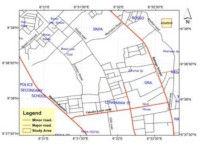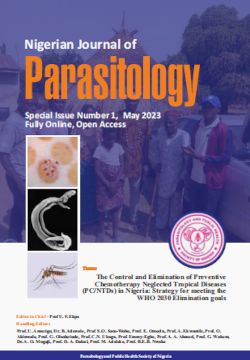Assessment of gastrointestinal parasites of slaughtered cattle, Minna, Niger State
http://dx.doi.org/10.4314/njpar.v40i1.19
Keywords:
prevalence, Minna, intensity, gastrointestinal parasites, CattleAbstract
Assessments of gastrointestinal parasites of slaughtered cattle at Minna Main Abattoir were conducted from November 2013 to February 2014. A total of 508 faecal samples (244 females, and 264 males) were examined for parasite ova using formol ether concentration technique. Results revealed that from the 508 faecal samples examined, helminths parasites (Paramphistomum sp., Trichostrongylus sp., Fasciola sp., Taenia sp., Monieza sp. and Oesophagostomum sp) were observed in 143 cattle representing 28.1%. Paramphistomum sp. had a higher prevalence of 8.9% and geometric mean intensity of 3.7 eggs per gram of faeces (epg), while the least (0.8%) prevalence was recorded for Oesophagostomum sp with mean intensity of 1.2 epg of faeces. Single infections were 26.2% and 1.9% for mixed infections. Females had a higher prevalence of infection of 31.8% than 24.2% for males with no significant difference (p> 0.05). Among age groups, higher prevalence of 33.4% was observed in adult cattle compared to young cattle (20.0%) and a significant difference in the prevalence of infection among the age groups (p<0.05). Parasites were more abundant in abomasum compared to large intestine, small intestine and caecum with a prevalence of 40.9%, 28.4%, 26.8%, and 16.5% respectively but no significant difference in both the intensity and prevalence of parasites isolated from various sections of the stomach (p>0.05). The high prevalence could pose a serious risk for infection to human infections, so adequate control measures are advocated in order to ensure disease free meat.
References
Adegbola, T. A. 1982. The feeding and nutrition of small ruminants. Proceedings 2nd National Workshop
on Small Ruminant Diseases and Production. University of Nigeria. Nsukka, 20-21pp.
Anene, M. B., Onyekwodiri, E. O., Chime, A. B. and Anika, S. M. 1993. Gastrointestinal parasites of sheep and goats of southeastern Nigeria. Small ruminant Resarch. Elvesier Science, 13: 187-192.
Nawathe, D. R., Sohael, A. S. andUmo, I. 1985. Health management of a dairy herd on the Jos Plateau (Nigeria). Bulletin Animal Health Production Africa, 33: 199-205.
Fikru, R., Teshale, S., Reta, D. and Yosef, K. 2006. Epidemiology of gastrointestinal parasites of ruminants in Western Oromia, Ethiopia. International Journal of Applied Resource Veterinary Medicine, 4(1): 51-57.
Berhe, G., Tadese, G., Kiros, H. and Negus, A. 2010. Concurrent infection of hydatidosis and fasciolosis in cattle slaughtered at Mekelle Municipal Abattoir, Tigray region. Ethiopia Veterinary Journal, 14(2): 39-49.
Irfan, M. 1984. Keynote address on effects of parasitism in lowering livestock population. Pakistan Veterinary Journal, 4(1): 25-27.
Anwar, A. H., Buriro, S. N. and Phulan A. 1995. A hydatidosis veterinary perspective in Pakistan. The Veterinarian, 4: 11-14.
Waller, P.J. 1997. Anthelmintic, resistance. Veterinary Parasitology, 72: 391-405.
Waller, P. J. 1999. International approaches to the concept of integrated control of nematodes parasites of livestock. International Journal of Parasitology, 29: 155-164.
Khin-khin, L. 2007. Prevalence of Cryptosporidia, giardia, and other gastrointestinal parasites of dairy calves in Mandalay, Myannar. Chuang Mai University and Frere Universiat Berlin, 98pp.
Siddiki A. Z., Uddin, M. B., Hossain, M. F., Rahmar, M. M., Das, B. C., Sarker, M. S. and Hussain, M. A. 2010. Coproscopic and haematologicalapproches to determine the prevalence of helminthiasis and protozoan diseases of red chittang cattle (RCC) breed in Bangladesh. Pakistan Veterinary Journal, 30(1): 1-6.
Jenkinsa, D. J., Romig, T.and Thompson, R. C. A. 2005. Emergence/re-emergence of Echinococcus spp. A global update. International Journal for Parasitology, 35: 1205- 1219.
Ashraf, K., Valero, M. A., Panova, M., Periago, M. V., Massoud, J. and Mas-Coma, S. 2006. Phenotypic analysis of adults of Fasciola gigantica and intermediate forms from the endemic region of Gilan. Iran International, 55: 249-260.
Yang, Y. R., Manus, D. P. and Heatth, D. D. 2009. Echinococcusgranulosus infection and options for control of cystic Echinococcus in Tibetan communities of western Sichuan province, China. Plos Neglected Tropical Disease, 3: 426.
Moulazadeh, P. and Zohoor, A. 2004. Prevalence of liver trematodes and hydatidcyste in Jiroft abattoir livestock. Journal of Shahid Sadoughi University of Medical Sciences and Health Services, 12: 10-14.
Youn, H. 2009. Review of zoonotic parasites in medical and veterinary fields in the Republic of Korea. Korean Journal of Parasitology, 47: 133-141.
Zuko, A. H. 2011. A slaughterhouse study on prevalence of sheep liver helminths in region of Sarajevo. Meso, 13: 102-104.
Zheng, Q., Chen, Y., Tian, L. G. and Zhou, X. N. 2009. Current situation and developmental trend of anthelmintics by bibliometrics. ZhongguoJi Sheng Chong Xue Yu Ji Sheng Chong Bing ZaZhi, 27: 347- 352.
Bisimwa, N. P., Lugano, R. M., Bwihangane, B. A., Wasso, S. D., Kinimi, E., Banswe, G. et al 2018. Prevalence of gastro-intestinal helminths in slaughtered cattle in Walungu Territory, South Kivu Province, Eastern Democratic Republic of Congo. Austin J Vet Sci and Anim Husb., 5(1): 1039.
Lemmy, E. E. and Egwunyenga, A. O. 2018. Epidemiological study on some parasitic helminths of cattle in Delta North, Delta State, Nigeria. J Anim Health Behav Sci., 2: 113.
Thrusfield, M. 2005. Surveys in Veterinary Pakistan. Journal of Veterinary Animal Science, 1: 14-17.
Blacklock, D. B. and Southwell, T. 1999. A guide to human parasitology (10th Edition). London: Lewis and Co. pp. 177-187.
Soulsby, E. J. L. 1982. Helminths, Arthropods and Protozoa of the domesticated Animals. 7th Ed. The English Language Book Soc. And BailliareTindall, London.
Cheesbrough, M. 1999. District Laboratory Practices in Tropical Countries. Part 1. Tropical Health Technology. United Kingdom: Cambridge University Press.
Duncan, D. B. 1955. Multiple range and multiple Ftests. Biometrics, 11: 1-42.
Darsema, G. 2009. Epidemiological study on major gastrointestinal helminth parasites of calves in three cattle farms in the western part of Amhara Region, Ethiopia. Ethiopian Veterinary Journal, 2: 9-18.
Shitta, K. B. and James-Rugus, N. N. 2013. Prevalence of gastro-intestinal helminthes of slaughtered cattle at Wukari Abattoir, Taraba State, North-eastern Nigeria. Nigerian Journal of Parasitology, 34: 55-59.
Abdi, J., Morarat, T.and Kheitokah, A. 2013. Prevalence of helminth parasitic diseases in industrial Abattoir in llam Province, Western Iran. Sky Journal of Microbiology Research, 1: 1-4.
Jelalu, K. and Yitegele, T. 2013. Prevalence of gastrointestinal of cattle in gedebanugutazerwolene Ethiopia. Journal of Veterinary Medicine and Hygiene, 5(12): 365-370.
Cheru, T., Birhanu, A., Diriba, L. and Eyob, E. 2014. Prevalence of gastrointestinal parasitism in East Showa Zone, Oromia Regional State. Central Ethiopia. Journal of Veterinary Medicine and Animal Health, 6: 54-62.
Nigatu, K. 2008. Gastrointestinal helminthosis of sheep in Awi Zone, north-eastern Ethiopia. Global Veterinarian, 12: 121-129.
Rahman, M. H. and Mondal, M. M. H. 1983. Helminth parasites of cattle (Bos indicus) in Bangladesh. Indian Journal of Parastology, 7(2): 173-174.
Rolfe, P. F. and Boray, J. C. 1987. Chemotherapy of paramphistomosis in cattle. Australian Veterinary Journal, 64(11): 328-332.
Sardar, S. A., Ehsan, M. A., Anower, A. K. M. M., Rahman, M. M. and Islam, M. A. 2006. Incidence of liver flukes and gastro-intestinal parasites in cattle. Bangladesh Journal of Veterinary Medicine, 4 (1): 39- 42.
Fritsche, T., Kaufmann, J. and Pfister, K. 1993. Parasite spectrum and seasonal epidemiology of gastrointestinal
nematodes of small ruminants in the Gambia. Veterinary Parasitology, 49(2-4): 271-283.
Regassa, F., Sori, T., Dhuguma, R. and Kiros, Y. 2006. Epidemiology of gastrointestinal parasites of ruminants in western Oroma, Ethiope. International Journal of Applied Research of Veterinary Medicine, 4 (1): 51-57.
Raza, A. M., Iqbal, Z., Jabbar, A. and Yaseen, M. 2007. Point prevalence of gastrointestinal helminthiasis in ruminants in southern Punjab. Pakistan Journal of Helminthology, 81: 323-328.
Radostits, O. M., Blood, D. C. and Gay, C. C. 1994. Diseases caused by helminth parasites. In: Veterinary Medicine: A textbook of diseases of cattle, sheep, pigs, goats and horses, 8th Edition. London, BalliereTindall, pp. 1223-1230.
Epherem, W. 2007. Prevalence of bovine gastrointestinal helminths in selected dairy farms of Addis Ababa, DVM Thesis, JUCAVM, Jimma, Ethiopia.

Downloads
Published
How to Cite
Issue
Section
License
Copyright (c) 2023 Nigerian Journal of Parasitology

This work is licensed under a Creative Commons Attribution-NonCommercial-NoDerivatives 4.0 International License.




